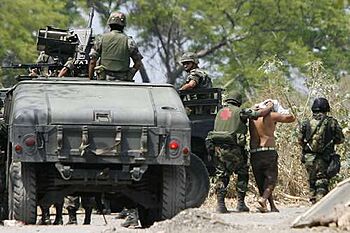Mexican drug war facts for kids
Quick facts for kids Mexican drug war |
|||||||
|---|---|---|---|---|---|---|---|
| Part of the war on drugs | |||||||
 The Mexican military detaining suspects in Michoacán, 2007 |
|||||||
|
|||||||
| Belligerents | |||||||
Consulting and training support by:
Guerrilla groups: |
Mexican cartels:
Weakened and defunct cartels: |
||||||
| Commanders and leaders | |||||||
|
|
||||||
| Strength | |||||||
|
Cartels:
|
||||||
| Casualties and losses | |||||||
|
Cartels:
|
||||||
Total casualties:
|
|||||||
The Mexican drug war is an ongoing conflict primarily between the Mexican government and various drug trafficking organizations, commonly referred to as cartels. This war has resulted in significant violence, corruption, and social upheaval within Mexico.
The conflict began in earnest in December 2006 when President Felipe Calderón deployed military forces to combat drug-related violence. The government's main objective was to dismantle the cartels that had become powerful across the country.
The Calderón administration's strategy involved deploying thousands of troops to combat cartel violence directly. This militarized approach has been criticized for escalating violence rather than reducing it. Subsequent administrations have continued this strategy with varying degrees of success.
In December 2018, President Andrés Manuel López Obrador declared an end to the war on drugs; however, violence has persisted, with homicide rates remaining high. Critics argue that simply declaring an end does not address the underlying issues fueling the conflict.
Aftermath
The drug war has exacerbated corruption within law enforcement and government institutions. Many officials have been bribed or coerced by cartel influences, undermining public trust in governance.
The violence has led to widespread suffering among civilians, including displacement and loss of life. The conflict has also resulted in a significant number of missing persons in Mexico. Since the onset of the war, estimates suggest that over 431,000 people have been killed, with tens of thousands more reported missing. By 2013, estimates indicated that at least 120,000 people had died as a result of the conflict.
See also
- Narcoculture in Mexico
- 2011 Mexican protests
- 2011–12 in the Mexican drug war
- Borderland Beat
- Mérida Initiative
- Uppsala Conflict Data Program
- List of ongoing armed conflicts
- List of journalists and media workers killed in Mexico

